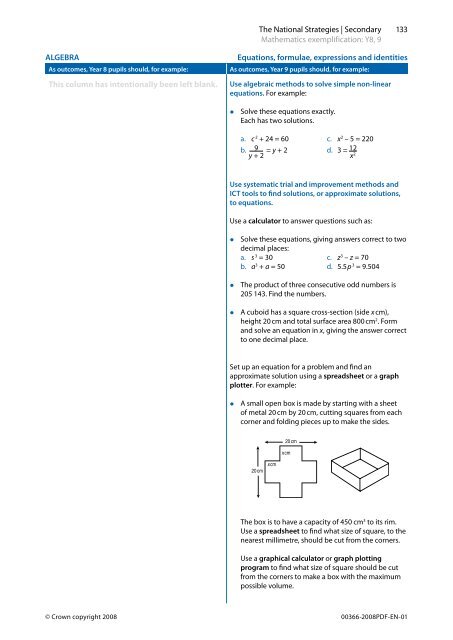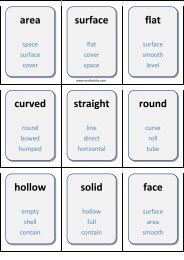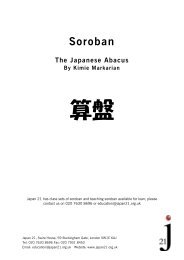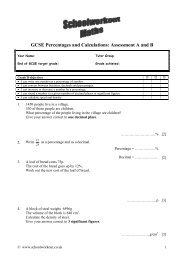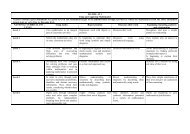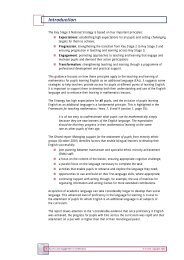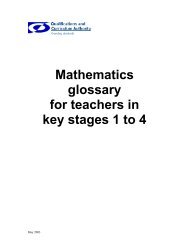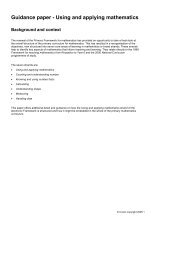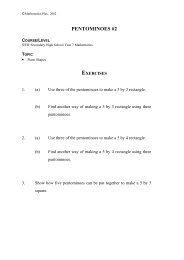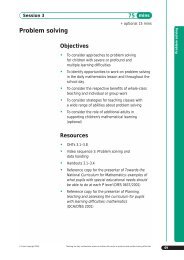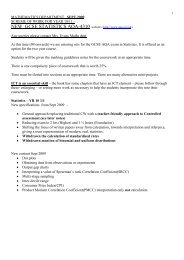ALGEBRA Equations, formulae, expressions and ... - Suffolk Maths
ALGEBRA Equations, formulae, expressions and ... - Suffolk Maths
ALGEBRA Equations, formulae, expressions and ... - Suffolk Maths
Create successful ePaper yourself
Turn your PDF publications into a flip-book with our unique Google optimized e-Paper software.
The National Strategies | Secondary<br />
Mathematics exemplification: Y8, 9<br />
133<br />
<strong>ALGEBRA</strong><br />
As outcomes, Year 8 pupils should, for example:<br />
This column has intentionally been left blank.<br />
<strong>Equations</strong>, <strong>formulae</strong>, <strong>expressions</strong> <strong>and</strong> identities<br />
As outcomes, Year 9 pupils should, for example:<br />
Use algebraic methods to solve simple non-linear<br />
equations. For example:<br />
• Solve these equations exactly.<br />
Each has two solutions.<br />
a. c 2 + 24 = 60 c. x 2 – 5 = 220<br />
b. 9 = y + 2<br />
y + 2<br />
d. 3 = 12<br />
x 2<br />
Use systematic trial <strong>and</strong> improvement methods <strong>and</strong><br />
ICT tools to find solutions, or approximate solutions,<br />
to equations.<br />
Use a calculator to answer questions such as:<br />
•<br />
Solve these equations, giving answers correct to two<br />
decimal places:<br />
a. s 3 = 30 c. z 3 – z = 70<br />
b. a 3 + a = 50 d. 5.5p 3 = 9.504<br />
• The product of three consecutive odd numbers is<br />
205 143. Find the numbers.<br />
•<br />
A cuboid has a square cross-section (side x cm),<br />
height 20 cm <strong>and</strong> total surface area 800 cm 2 . Form<br />
<strong>and</strong> solve an equation in x, giving the answer correct<br />
to one decimal place.<br />
Set up an equation for a problem <strong>and</strong> find an<br />
approximate solution using a spreadsheet or a graph<br />
plotter. For example:<br />
• A small open box is made by starting with a sheet<br />
of metal 20 cm by 20 cm, cutting squares from each<br />
corner <strong>and</strong> folding pieces up to make the sides.<br />
20 cm<br />
x cm<br />
20 cm<br />
x cm<br />
The box is to have a capacity of 450 cm 3 to its rim.<br />
Use a spreadsheet to find what size of square, to the<br />
nearest millimetre, should be cut from the corners.<br />
Use a graphical calculator or graph plotting<br />
program to find what size of square should be cut<br />
from the corners to make a box with the maximum<br />
possible volume.<br />
© Crown copyright 2008 00366-2008PDF-EN-01


